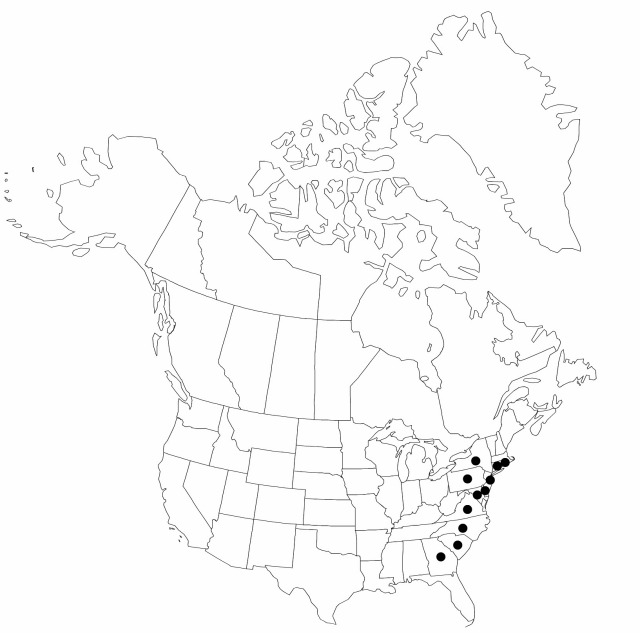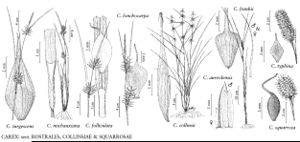Carex collinsii
Gen. N. Amer. Pl. 2: 205. 1818.
Culms trigonous with obtuse angles, 15–75 cm, to 3 mm diam. at base, glabrous. Leaves: sheaths to 2.5 cm; blades 30–35 cm × 5 mm. Inflorescences 10–30 cm; peduncles of proximal spikes to 4 cm; bracts 8–15 cm × 3–5 mm, shorter than inflorescences; lateral spikes 4–5, 6–10-flowered, 1 × 2.5 cm. Scales white or translucent with green midvein, ovate, body to 2.5 mm, less than 0.5 length of perigynia, herbaceous, apex acute, acuminate or mucronate, awn to 0.5 mm. Perigynia green with redbrown spots, 15–20 raised veins, to 15 × 1.2 mm; beak obliquely cut, herbaceous, teeth cartilaginous, to 1 mm; style curved, short stigmas protruding from perigynium at base of oblique orifice. Achenes yellowbrown, oblong, obtusely angled, 3 × 1 mm, tightly enclosed by perigynia, dull.
Phenology: Fruiting Jul–Aug.
Habitat: Shaded sphagnum bogs or seeps, characteristically under Chamaecyparis thyoides or Picea mariana
Elevation: 0–700 m
Distribution

Conn., Del., Ga., Md., N.J., N.Y., N.C., Pa., R.I., S.C., Va.
Discussion
Nuttall did not designate a type specimen for Carex collinsii; he clearly did not intend that name to provide a legitimate name for the later homonym C. subulata Michaux, but listed both of the names. As K. K. Mackenzie (1931–1935, parts 2–3, pp. 704–705) pointed out, the locality of the type specimen for C. subulata Michaux is apparently erroneous because that species does not occur in Canada. The specimen in the Michaux herbarium (P, photo!) is C. collinsii.
Selected References
None.
Lower Taxa
"shortened" is not a number."lengthofperigynia" is not declared as a valid unit of measurement for this property.
